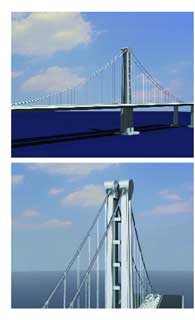|
 To
nonresidents of San Francisco, it may be surprising that the
design of a new, more earthquake-resistant Bay Bridge is only
now nearing completion nine years after the 1989 Lo To
nonresidents of San Francisco, it may be surprising that the
design of a new, more earthquake-resistant Bay Bridge is only
now nearing completion nine years after the 1989 Lo ma
Prieta earthquake. But for residents of this city encumbered
by politics and special interest groups, replacement of the
58-year-old span cannot be over-studied, over-discussed or over-designed. ma
Prieta earthquake. But for residents of this city encumbered
by politics and special interest groups, replacement of the
58-year-old span cannot be over-studied, over-discussed or over-designed.
Currently
on the boards (or on the screens) are four alternative designs
for the two-mile long, $1.2 billion east span of the San Francisco-Oakland
Bay Bridge, slated to begin construction in the year 2000 and
open in 2003-2004. Under the aegis of the California Department
of Transportation and T.Y. Linn International, the San Francisco
architectural firm Donald MacDonald Architects is developing
two of the bridge designs using ArchiCAD.
"You
get 3D results instantly with ArchiCAD, which is crucial in
the early design stage,² MacDonald
said.
With
the help of ArchiCAD, MacDonaldıs team modeled and presented
six suspension bridge schemes to the Bay Bridge Design Task
Force and Engineering and Design Advisory Panel in only four
weeks.
In
addition to the obvious requirement of earthquake resistance
‹ the two mile span must withstand an earthquake of 8.3 on the
Richter scale ‹ MacDonald had to include a bike lane, study
views for both cyclists and motorists, consider the effects
of added pollution to the Bay and adjacent Oakland wetlands,
and accommodate the constraints of navigation channels and setting
foundations on the Bayıs muddy floor.
MacDonald
notes that the bridge design should work in the context of the
man-made environment. "The designs are based not only on how
to carry the stresses, but also the context in which they are
placed. We decided to keep the necklace of suspension bridges
across the Bay intact to keep the continuity of design. It is
more modern but similar in scale,² MacDonald said.
Bridge
design is not new to MacDonald. A recently completed project
to retrofit the Golden Gate Bridge afforded him the opportunity
to further understand not only the engineering and architectural
principles which drive design, but the social awareness surrounding
a national landmark as well. Since opening his practice in 1965,
MacDonald has received numerous awards for such diverse projects
as low-to middle-income housing, bridge design, urban infill
and commercial projects.
The
Bay Bridge Design Task Force commissioned two teams to develop
designs for self-anchored suspension and cable-stayed bridges.
MacDonaldıs team developed six suspension designs while another
team within T.Y. Linnıs office developed the cable stay schemes.
After an initial review in early March, two suspension ‹ a twin
tower and a single tower ‹ and two cable stay designs were selected
for further development. If chosen, the single-tower, self-anchored
suspension bridge (shown at left) would be the first in the
world. The task force is scheduled to select among the four
designs in June of 1998.
Having
used ArchiCAD for many projects in the past two years, MacDonald
appreciates that he can keep his overhead low thanks to the
softwareıs efficiency. "Iım able to keep my office lean and
productive now,² MacDonald said. "You can get started so quickly
because the learning curve is so much shorter than other CAD
programs.²
|